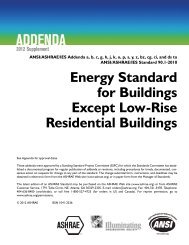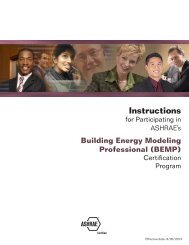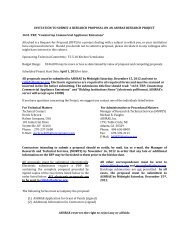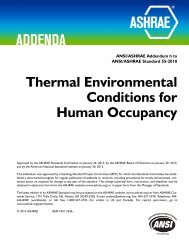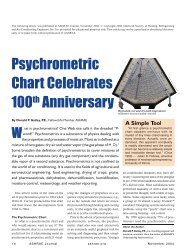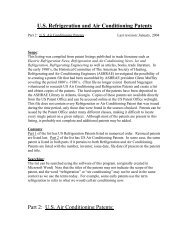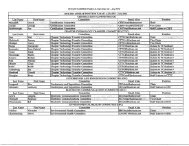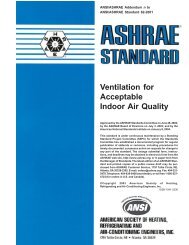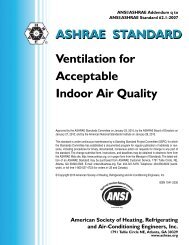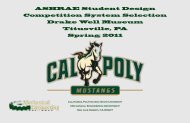ANSI/ASHRAE Standard 62.1-2007 ASHRAE STANDARD Ventilation
ANSI/ASHRAE Standard 62.1-2007 ASHRAE STANDARD Ventilation
ANSI/ASHRAE Standard 62.1-2007 ASHRAE STANDARD Ventilation
You also want an ePaper? Increase the reach of your titles
YUMPU automatically turns print PDFs into web optimized ePapers that Google loves.
(This foreword is not part of this standard. It is merely<br />
informative and does not contain requirements necessary<br />
for conformance to the standard. It has not been<br />
processed according to the <strong>ANSI</strong> requirements for a<br />
standard and may contain material that has not been<br />
subject to public review or a consensus process.<br />
Unresolved objectors on informative material are not<br />
offered the right to appeal at <strong>ASHRAE</strong> or <strong>ANSI</strong>.)<br />
FOREWORD<br />
This addendum has been developed in response to a<br />
change proposal; with additional changes resulting from public<br />
review comments. It provides additional information for<br />
demand controlled ventilation (DCV) systems to augment Section<br />
6.2.7 Dynamic Reset.<br />
Note: In this addendum, changes to the current standard<br />
are indicated in the text by underlining (for additions)<br />
and strikethrough (for deletions) unless the instructions specifically<br />
mention some other means of indicating the<br />
changes.<br />
Addendum g to <strong>Standard</strong> <strong>62.1</strong>-<strong>2007</strong><br />
Note: Add the following definition to Section 3 Definitions:<br />
demand controlled ventilation (DCV): any means by which<br />
the breathing zone outdoor air flow (V bz ) can be varied to the<br />
occupied space or spaces based on the actual or estimated<br />
number of occupants and/or ventilation requirements of the<br />
occupied zone.<br />
Note: Revise Section 6.2.7 as follows:<br />
6.2.7 Dynamic Reset. The system may be designed to<br />
reset the design outdoor air intake flow (V ot ) and/or space or<br />
ventilation zone airflow (V oz ) as operating conditions change.<br />
These conditions include but are not limited to:<br />
1. Variations in occupancy or ventilation airflow in one or<br />
more individual zones for which ventilation airflow<br />
requirements will be reset.<br />
Note: Examples of measures for estimating such variations<br />
include: occupancy scheduled by time-of-day, a direct<br />
count of occupants, or an estimate of occupancy or ventilation<br />
rate per person using occupancy sensors such as those based<br />
on indoor CO2 concentrations.<br />
6.2.7.1 Demand Control <strong>Ventilation</strong> (DCV).<br />
6.2.7.1.1 DCV shall be permitted as an optional<br />
means of dynamic reset.<br />
Exception: CO 2-based DCV shall not be applied in zones<br />
with indoor sources of CO 2 other than occupants or with CO 2<br />
removal mechanisms, such as gaseous air cleaners.<br />
6.2.7.1.2 The breathing zone outdoor airflow (V bz )<br />
shall be reset in response to current occupancy and shall be no<br />
less than the building component (R a *A z ) of the DCV zone.<br />
Note: Examples of reset methods or devices include<br />
population counters, carbon dioxide (CO 2 ) sensors, timers,<br />
occupancy schedules or occupancy sensors.<br />
6.2.7.1.3 The ventilation system shall be controlled<br />
such that at steady-state it provides each zone with no less<br />
than the breathing zone outdoor airflow (V bz ) for the current<br />
zone population.<br />
6.2.7.1.4 When the mechanical air-conditioning system<br />
is dehumidifying, the current total outdoor air intake flow<br />
for the building shall be no less than the coincident total<br />
exhaust airflow.<br />
6.2.7.1.5 Documentation: A written description of<br />
the equipment, methods, control sequences, set points, and<br />
the intended operational functions shall be provided. A table<br />
shall be provided that shows the minimum and maximum outdoor<br />
intake airflow for each system.<br />
2.6.2.7.2 <strong>Ventilation</strong> Efficiency. Variations in the<br />
efficiency with which outdoor air is distributed to the<br />
occupants under different ventilation system airflows and<br />
temperatures shall be permitted as an optional basis of<br />
dynamic reset.<br />
3.6.2.7.3 Outdoor Air Fraction. A higher fraction of<br />
outdoor air in the air supply due to intake of additional<br />
outdoor air for free cooling or exhaust air makeup shall be<br />
permitted as an optional basis of dynamic reset.<br />
Note: Modify Section 6.4 as follows:<br />
6.4 Design Documentation Procedures. Design criteria<br />
and assumptions shall be documented and should be made<br />
available for operation of the system within a reasonable time<br />
after installation. See Sections 4.3, 5.2.3, 5.17.4, 6.2.7.1.5,<br />
and 6.3.2 regarding assumptions that should be detailed in the<br />
documentation.<br />
<strong>ANSI</strong>/<strong>ASHRAE</strong> Addenda g, r, and t to <strong>ANSI</strong>/<strong>ASHRAE</strong> <strong>Standard</strong> <strong>62.1</strong>-<strong>2007</strong> 1



